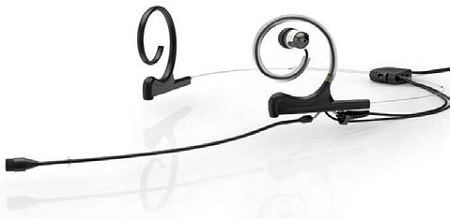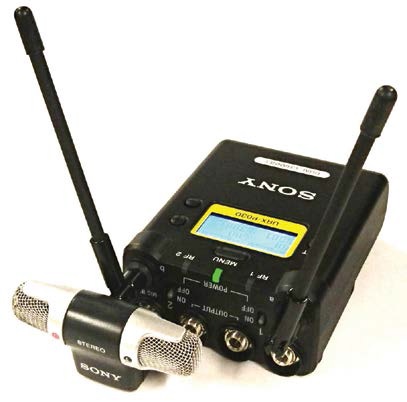Mics Adapt to Changing News Environs
NEW YORK—Smaller, cheaper, less obtrusive. That pretty much sums up the trajectory that mojo (mobile journalism) has been following in the last year. Some predicted it, but many resisted the notion that the cellphone would one day be seen as an acceptable platform to shoot video for at least some broadcast applications. That day has arrived.
Obviously, the quality of the video you shoot on your iPhone does not compete with recordings made on a professional device. In many cases, however, the general public is accepting these images. The audio that onboard microphones capture, however, leaves something to be desired.
SHURE MOTIV

Shure’s MV88 ioS Digital Stereo condenser Microphone Shure released the Motiv product line in September 2015 in part to address this. Of the five products in the range, the MV88 iOS Digital Stereo Condenser Microphone is the most relevant for TV and radio applications. It plugs directly into the lightning port of any iOS-based device that has one, and Shure provides a free app that lets the user configure settings to customize the sound of the mic at the point of capture, so he or she doesn’t have to worry about correcting things in post.
“Once you make settings for gain, EQ and compression, these settings remain on the microphone itself, which makes it easy to move between different devices,” says Soren Pedersen, product specialist for wired microphones for the Chicago-based audio vendor. “That’s the direction mojo is going. The MV88 fits in your pocket right next to your phone.”
The Android platform is open source, and that creates problems for manufacturers, according to Pedersen, who says that the fact that there are currently about 22,000 different Android devices on the markets has made it difficult for Shure to integrate the MV88 with Android phones. MV88 specs are hard to complain about, particularly since the microphone has a MAP of only $149. The A/D converter goes all the way up to 24-bit/48 kHz and the frequency response spans the full range, from 20 HZ to 20,00 HZ. Shure’s goal was to develop a microphone that that helps turn the iPhone into a full service mobile recorder.
THE DISCREET LOOK
The professional video industry's #1 source for news, trends and product and tech information. Sign up below.

DPA d:fine In-Ear Broadcast headset Microphone Denmark-based DPA Microphones has a direct view of the European broadcast industry. James Capparelle, marketing manager, USA for DPA says that European studios have been stressing a tapered look for some time, and the U.S. market seems to be catching up.
“DPA is a Danish company, and that influence is something we try to introduce to the American markets throughout our entire product line,” he said. “We realized that television stations and news networks were leaning towards a discreet, less invasive look. Our d:fine In-Ear Broadcast Headset Microphone, which we released in January of 2015, is less visible than large over-the-ear headphone/microphones combinations.”
CNN used d:fine headset microphones throughout the recent series of presidential primary debates. “We assume that CNN chose this microphone for two reasons,” says Capparelle. “One, the capsule’s unparalleled ability to reject unwanted background noise, and two, its unobtrusive presence from the camera’s perspective.”
DPA also offers the d:screet Slim Miniature Microphone, a more discrete lavalier mic. Caparelle says that the Slim has gained considerable traction in the film and television areas, where hiding the presence of a microphone is critical. DPA also says its d:facto Interview microphone has wind rejection that is superior to any other product on the market.
TWO CHANNELS IN ONE

Sony’s URX-PO3D dual-channel portable wireless receiver Sony has released updates to both its UWP-D two channel portable and slot in receivers. Sony shouldercams feature a slot in the back which integrates well with their new URXS03D two-channel slot-in wireless receiver, providing a direct digital audio internal interface. The device is cosmetically clean, no external wires are required, and even some metadata information (audio and RF level) is included that is shared with the camcorder display.
Sony also has a new body pack transmitter, the UTX-B03HR, that has a four-pin Hirose lavalier mic connector that allows for connection with their ECM-77BC/9X lavalier mic. It’s a very robust connecter, especially for broadcast field applications.
According to Andy Munitz, professional audio product manager for Sony, the URXPO3D dual-channel portable wireless receiver is particularly relevant. “Operators who use smaller cameras, ones that don’t have a slot-in architecture, may want the ability to have two channels of wireless in one unit, as opposed to having two separate single channel receivers Velcro-ed together and jury-rigged mounted onto a camera,” Munitz said. “This is our first two-channel portable battery-operated receiver for easy camera mounting. It is also fully compatible with all of our UWP-D family transmitters and even has backwards compatibility with many Sony legacy analog transmitters from the past.”
A unique aspect about the receiver according to Munitze, is its integration with many Sony camcorders that utilize the “MI shoe,” or multi-interface architecture. “The new SMAD-P3D MI shoe supports two audio channels and camera battery powering,” he said. “We’ve also added an internal mixer function in the URX-P03D that allows either of the wireless channels to be routed out of either of the unit’s outputs or routed to both channels simultaneously.”
Panning, which could be confusing, is simplified by taking channel one, which has talent one, for example, and mapping it to both output channels, which results in that audio coming out in the center. The operator could do the same thing for the second talent.
“We’ve taken things one step further, and this is quite important,” says Munitz. “We’ve added a local microphone input on the receiver itself which accepts either a mono or stereo source, essentially turning the unit into a four input receiver which can be mixed down to the two outputs.
